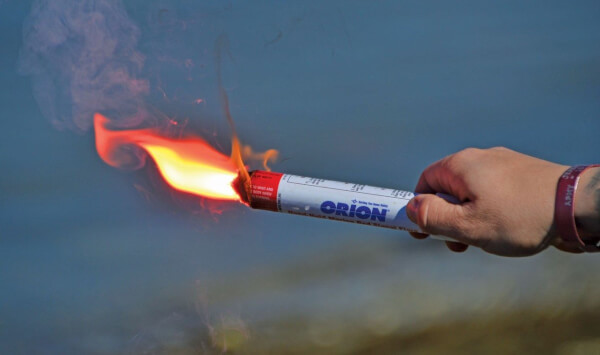Marine flares are listed under two categories: United States Coast Guard (USCG) approved flares, and Safety of Life at Sea (SOLAS) which meet minimum international requirements but are not certified in the United States. USCG approved flares are required for recreational boats when used on U.S. coastal waters, the Great Lakes and territorial seas with connected waters, and U.S. owned boats operating on the high seas. Boats under 16 feet, participating in organized events such as regattas or parades, open sailboats under 26 feet without motors, or manually propelled boats are exempt from carrying flares during daytime use however must carry when operating at night.

Flares come in handheld and aerial types.
Handheld flares produce flames or smoke. Flare guns and flare tubes launch aerial flares, emitting a red or white smoke trail, or launch a parachute and red smoke trail. Different chemical combinations produce the flames or smoke. Orange smoke flares are for daylight use, while red and white flares are primarily used at night. Their burning times and distance vary by flare type. Flare guns are considered a firearm in some states. Check your state regulations before purchasing.

Vessels are required to have three unexpired safety flares.
The USCG approved flares are stamped with an expiration date and certification number. They expire in 42 months, and by law must be replaced, or boaters suffer a penalty of $1,100. Inland boaters require handheld red flares and/or aerial flares. Coastal daytime boaters going occasionally offshore require handheld red flares, orange smoke flares, and aerial flares. Extended time offshore boaters should carry SOLAS approved handheld flares, smoke flares and aerial flares. Igniting a red flare without an emergency is illegal.

Orion handhelds (with cardboard tubes) have been the only marine USCG approved flare for 50 years.
To activate remove the plastic cap and strike the cap across the ignition button. Additionally, Aurora is the newest USCG approved (steel tube) red flare on the market, having a cord that’s easily pulled upward for flare activation, or downward for orange smoke flares.
“Expended flares from search and rescue cases usually end up in the ocean,” said BM1 JJ Kinstrey, Operations Petty Officer, USCG, Motor Lifeboat Station, Fort Macon, NC. “…there is really no way to put it out until it burns out. If dropped in a plastic bucket of water on a boat it will just burn through the bucket and your boat.” When completely burned out, then cool it with water.

Safety Flare workshops are available from the USCG, Coast Guard Auxiliary or US Power Squadrons.
CG Auxiliary, Power Squadrons and many fire departments, will take expired flares. “However, I recommend to people they actually keep them on the boat,” said Kinstrey. “If I am ever sinking in my boat, I want a giant bucket of flares to use rather than just three. You’re allowed to keep old flares as long as you have the required amount of good ones to pass inspection or a CG boarding. I have never seen a flare that failed to fire and I have shot off some pretty OLD flares,” said BM1 Kinstrey.

Flare Tips:
- Many emergencies occur at night, so learn about flares in the daytime.
- Read the flare package for directions, usage and burning time.
- Inspect your flares yearly. Mark expired ones and keep them together, using new flares first. Add fireproof gloves to a watertight storage unit, away from heat and accessible.
- Remove flares from long-term stored boats.
- Store flare guns unloaded. In a “hang-fire,” wait 30 seconds before ejecting the cartridge.
- Don’t use bent or broken flares, and never put flares in the trash or incinerate.
- Hold red flares 45 degrees outward so the slag does not drip on your hand, on combustible materials, or onto the boat. Do not breathe the smoke.
- Shoot aerial flares after identifying possible rescue vessels. Aim leeward, at one o’clock for the greatest visual attention, and prepare to use other flares.
(Sincere thanks to BM2 Matthew Asire and BM3 Cameron Haywood, Petty Officers at the US Coast Guard Motor Lifeboat Station Fort Macon, Atlantic Beach, N.C.)
Helen Aitken is a writer and photographer from eastern N.C. who loves classic wooden boats, “backyard” boat makers, coastal areas, and contributes regularly to All At Sea Southeast magazine. Visit her website at www.helenaitken.com.





